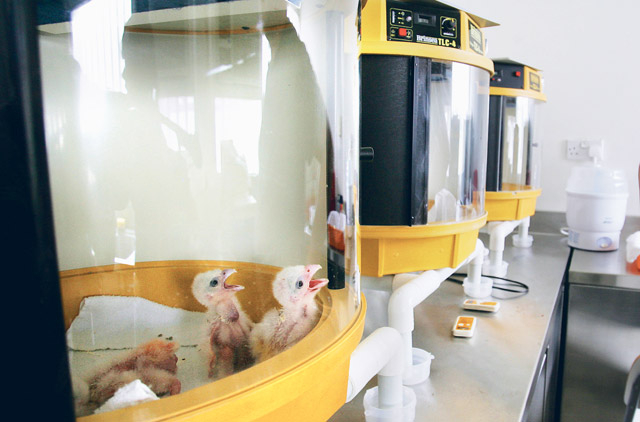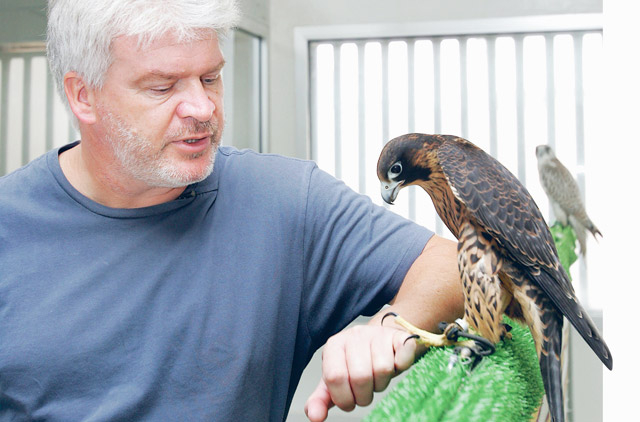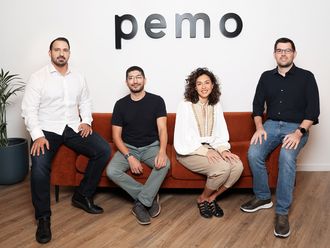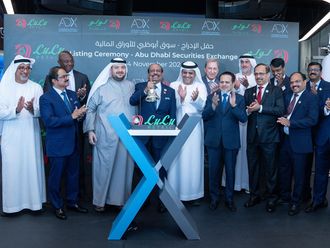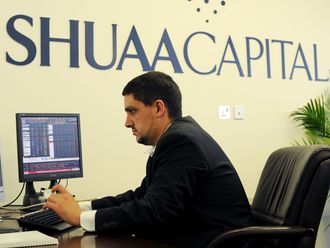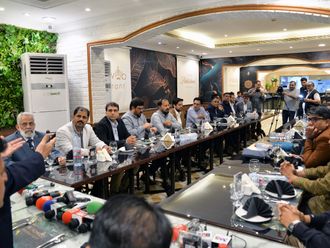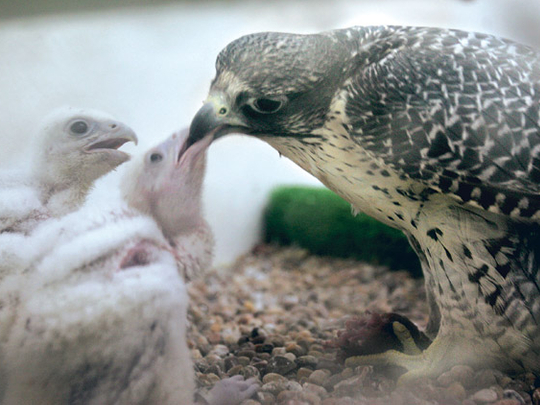
Open-mouthed and featherless, three falcon chicks crane their necks toward their mother as she tears chunks of meat from a fresh quail and gingerly feeds her wide-eyed young.
Safe beneath their mother's vigilant lookout, the shrill crying of the hungry brood in the nest is a scene that has played itself out in remote rocky reaches of the globe from time immemorial.
But in this instance, the gravel substrate beneath the chicks is part of a triangular man-made nest positioned in a breeding chamber deep inside the UAE's only commercial falcon breeding facility — the Nad Al Sheba Avian Reproduction Research Centre.
The fabled goose that laid the golden egg, it would appear, has changed its feathers.
Today, it is the rare and magnificent falcon raised in captivity that is laying four to 15 golden eggs a year, that ultimately, as adults, fetch more than $30,000 (Dh110,100) apiece when sold as full-grown hunting birds.
Breeding, raising and selling falcons is big business for the centre, producing more than 200 fully grown specimens a year for sale in an international industry worth untold billions annually.
Opened in the spring of 2001 by owner Mohammad Hilal Bin Tarraf, 36 falcons were raised in the centre in its first year.
By the end of this year's spring-breeding season, there could be more than 250 fully grown falcons in the most productive year ever, said David Le Mesurier (pictured below), avian centre manager.
"I don't count my chickens before they're hatched but I have a lot of eggs at the end of the month," Le Mesurier told Gulf News during a tour inside the facility.
A UK expatriate who has raised falcons since the age of 12, Le Mesurier helped custom design the avian centre to create a comfortable environment for the hundreds of breeding falcons he maintains, as well as the hunting-bird offspring that are sold each year to enthusiasts both domestically and abroad.
Breeding chambers
In five large breeding buildings, 112 specially designed breeding chambers include, for example, one-way observation windows that face away from nests at a 45-degree angle to avoid birds seeing their reflections.
Chamber entry doors open into the room rather than against the wall, he said, to prevent birds from flying out into the long hallways where clipboards hang at each chamber doorway, with charts carefully logging all aspects of the young birds' formative years, before release and sale.
Attention to detail is the backbone of Le Mesurier's business acumen when it comes to caring for each and every falcon, he said.
"It makes good business sense," he said.
When people shell out large amounts of money, they want only the best money can buy.
"As far as I'm aware, we're the only commercial breeding project in the UAE. We produce very high quality birds. They will always sell," he said, adding that it's all about "selling high quality product at a good price".
On the business front, Le Mesurier said the yearly market strategy is to stay ahead of competitors by offering its birds for sale at the beginning of the autumnal falconry hunting season, at a time when foreign falcon representatives enter the UAE to offer their birds as well.
The falcon reproduction centre sells about 80 per cent of its birds to Emirati Shaikhs in the UAE, he said.
"Within three or four days, all of our birds are sold."
Le Mesurier said that although the breeding centre was born out of a need to help promote the species, it is a business, and after a decade of solid growth does "make a good profit".
Given that the centre is private, its financial figures are proprietary and are not released publicly.
The global industry is similar, he said, with breeding centres around the globe keeping their year-end earnings and client lists close to their chest to remain competitive, although international shipments of birds are tracked through CITES (Convention on International Trade in Endangered Species).
Staying in the black can be a challenge for a facility where a staff of 10 oversees a sophisticated secure environment that leaves nothing to chance thanks to the latest in technology.
To ensure the health of each and every new falcon, the centre is designed to keep bacteria and viruses in check — people visiting cannot enter without stepping into a shallow pool of disinfectant at the doorways to breeding-chamber buildings.
Once inside, an elaborate series of enclosed antiseptic-clean rooms house each stage of the young bird's growth.
The buildings feature climate-controlling air conditioner systems (two for redundancy in case one system fails) as well as ultra-violet sterilised ventilation to maintain proper air movement throughout.
Clean environment
"It has to be a very good closed environment. It has to be very clean," he said.
At the newly laid egg stage, Le Mesurier is a consummate professional as he preps at a wash station before immersing eggs in a sterile solution.
"Each egg is numbered, washed and measured and entered into the computer system," he said, before placement in the incubator room where tiny eggs can be seen rocking back and forth as the embryos move inside.
After a 31-day gestation period, the eggs hatch and the broken egg shells are sent away for DNA analysis "to determine the sex of the bird".
The newly hatched chicks are moved to the brooder rooms where they are kept in temperature-controlled brooding machines, monitored and fed until they are returned to their mother's nest, he said.
It is here in the nest where the birds learn that they are falcons, imprinting on their mother who feeds the youngsters quail meat daily, mimicking feeding rituals in the wild.
Depending on how many birds are hatched and nesting on any given day, Le Mesurier said the aviary centre can go through 400-800 quail meal birds a day.
Le Mesurier said that in order to avoid the expense of importing quail meat (and the risk of infection) a quail farm was built on site to meet the voracious appetites of the young birds.
"We can't bring food in because of the risk of contamination," Le Mesurier said. "We're completely self-sustained."
When the falcons are only six days old and resting in the brooder machines, the chicks are hand-fed "finely minced quail about five times a day", he said, adding that as the birds mature in the nest, the food is given directly from the mother's beak.
Species
As the birds mature, Le Mesurier said the best white and black specimens are retained for breeding and the remainder are sold as hunting falcons.
There are two species of falcon sold from the centre: Gyr falcons, as well as Peregrine falcons.
While not native to the Arabian Peninsula, Peregrine falcons have been visiting the UAE for thousands of years during their annual migration, he said, when "they come down in the autumn".
However, Le Mesurier said that his clients travel outside of the country along with their birds to practise the time-honoured sport of falconry.
So what makes the reproduction centre so successful?
Le Mesurier said it still comes down to that same feeling he had as a young lad raising falcons in the UK. "I have a feeling for it," he said, adding, "it's not a job."
Falconry's roots in the Middle East
More than half of the world's falconers hail from the Middle East, a region that enjoys one of the longest recorded associations with the falcon, according to the International Association for Falconry and Conservation of Birds of Prey.
The IAF says that falconry dates back to 3500 BC in what was known as the Al Rafidein region (Iraq) and by 2000 BC the sport had earned a mention by Gilgamesh.
On its website, the association states in an historical report that the "Gulf region became famous for its falconers and falconry traditions. Through Arab influence it spread out through the Islamic world, eastwards into the great Islamic Empires of Central Asia and westwards across North Africa to the Magreb, giving us the distinctive styles of falconry of the Bedouin, of the Kingdom of Morroco and the Magreb and of Tunisia."
Falconry in the Middle East has always enjoyed connections to royalty.
Research shows that "Al Harith Bin Mu'awiya, an early king of the present region that includes Saudi Arabia, was one of the first who trained and hunted falcons."
The Arabian love and longstanding union with the birds down through time has forged a deep philosophical impression on Arab society as well, reports the association.
"In the philosophy of the region, hunting trips teach patience, endurance and self-reliance and bravery can be learned from falcons," the IAF said.


